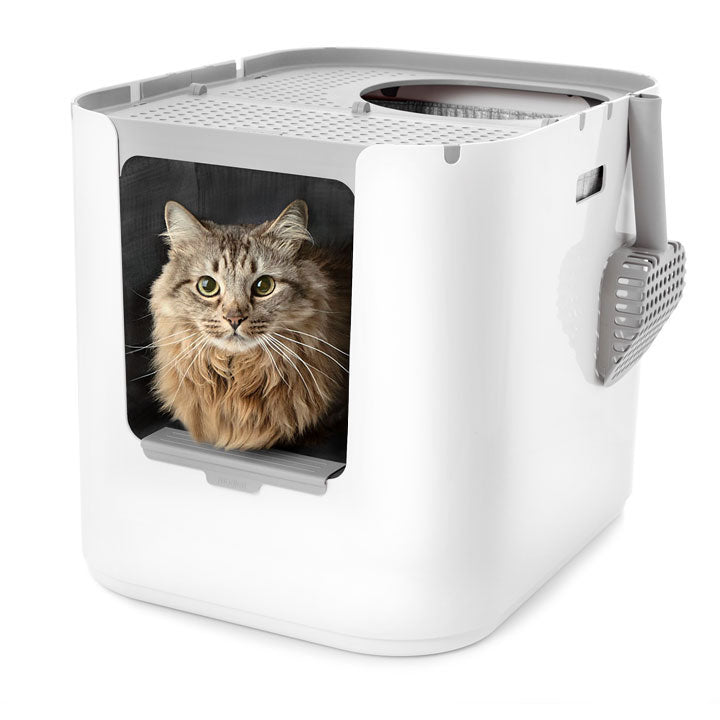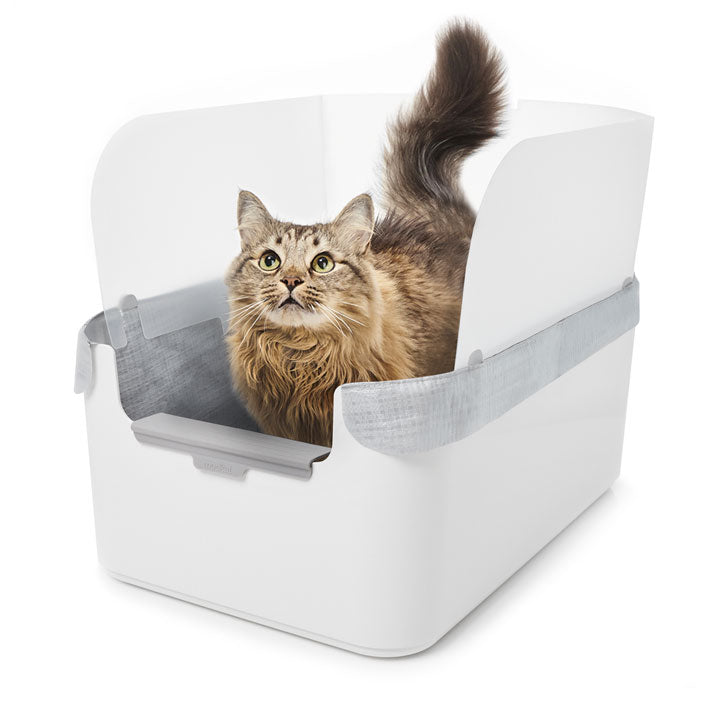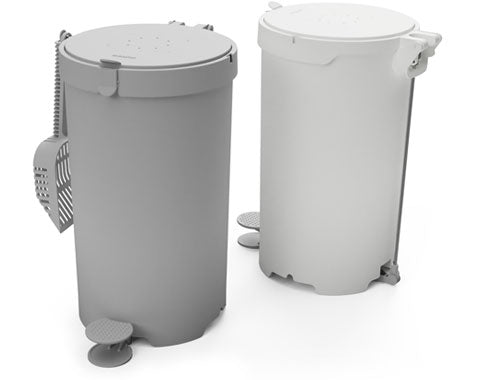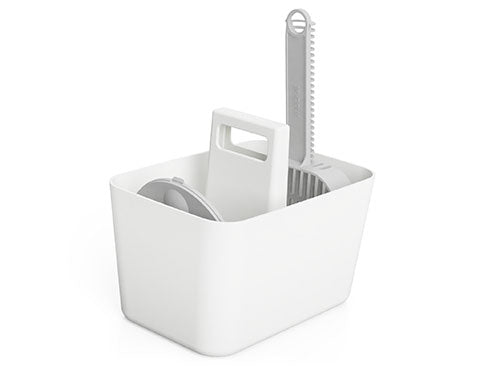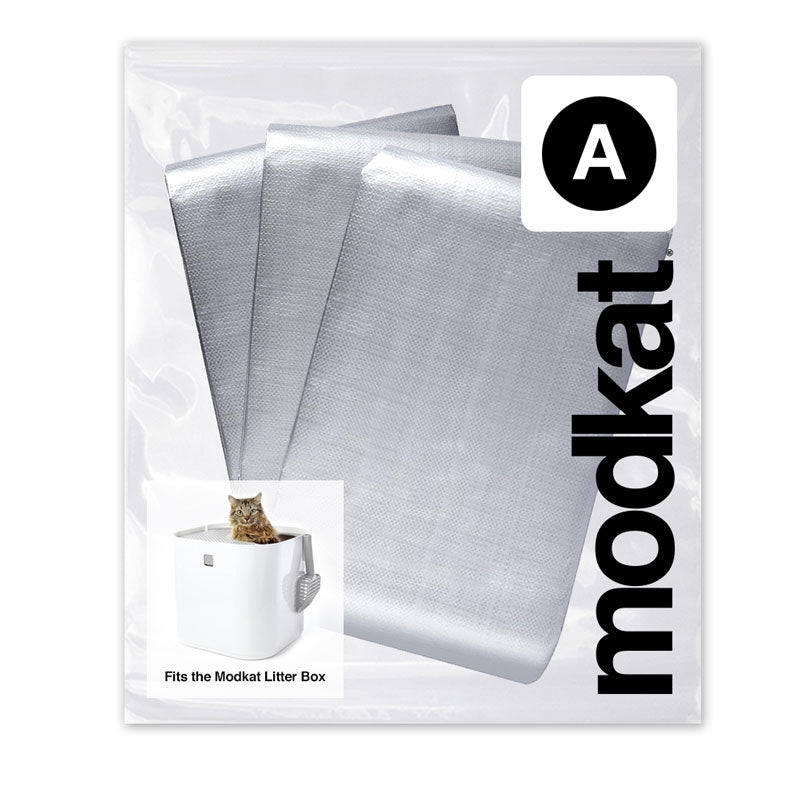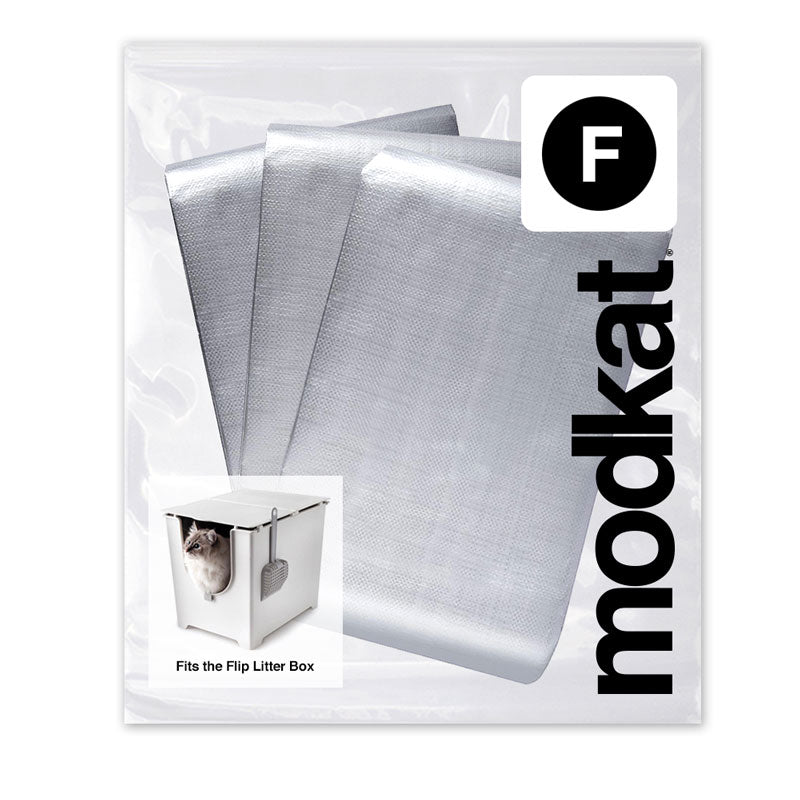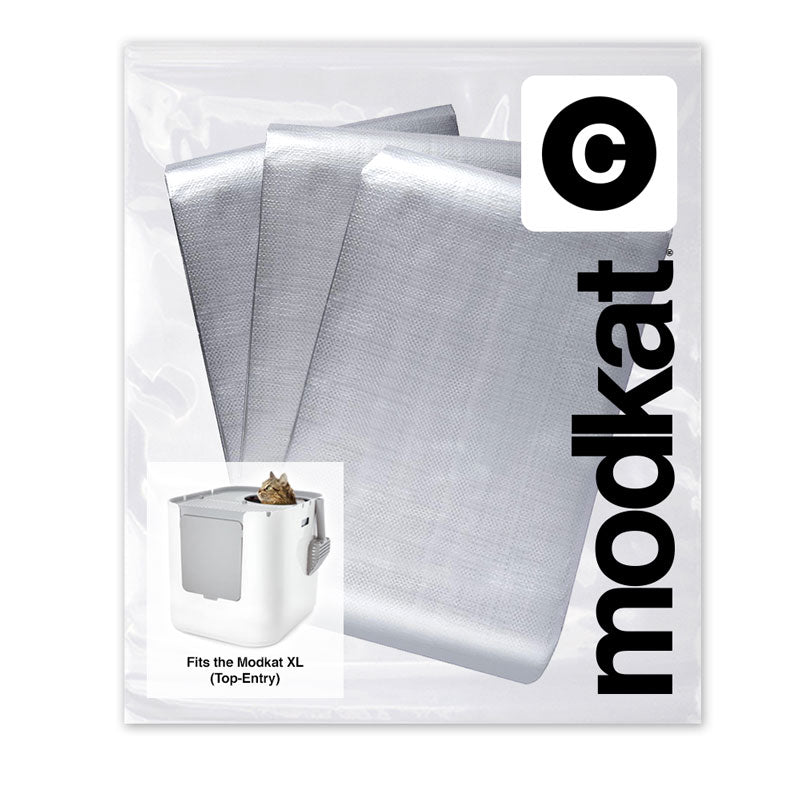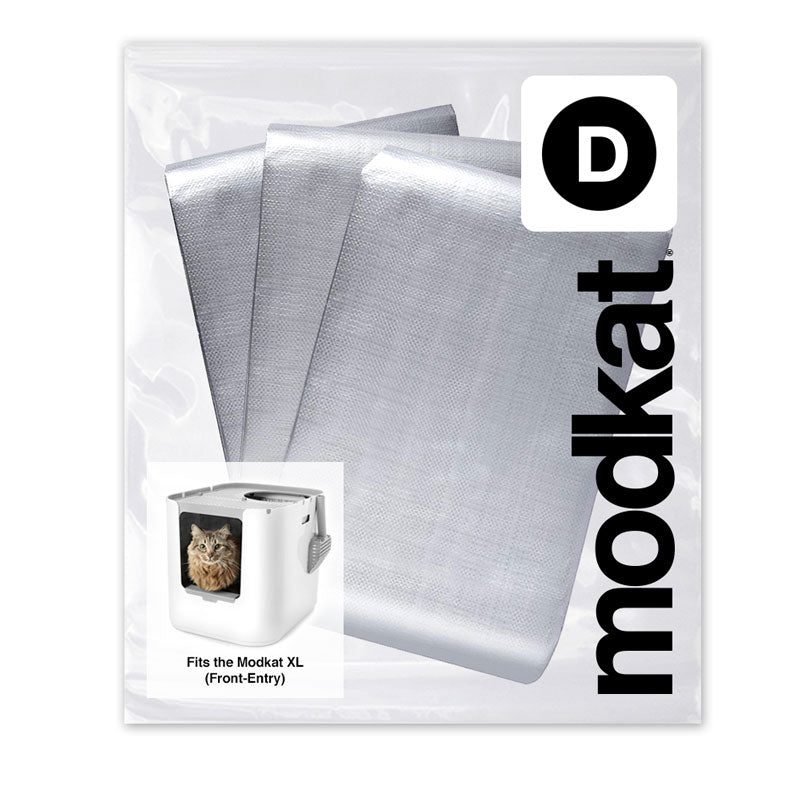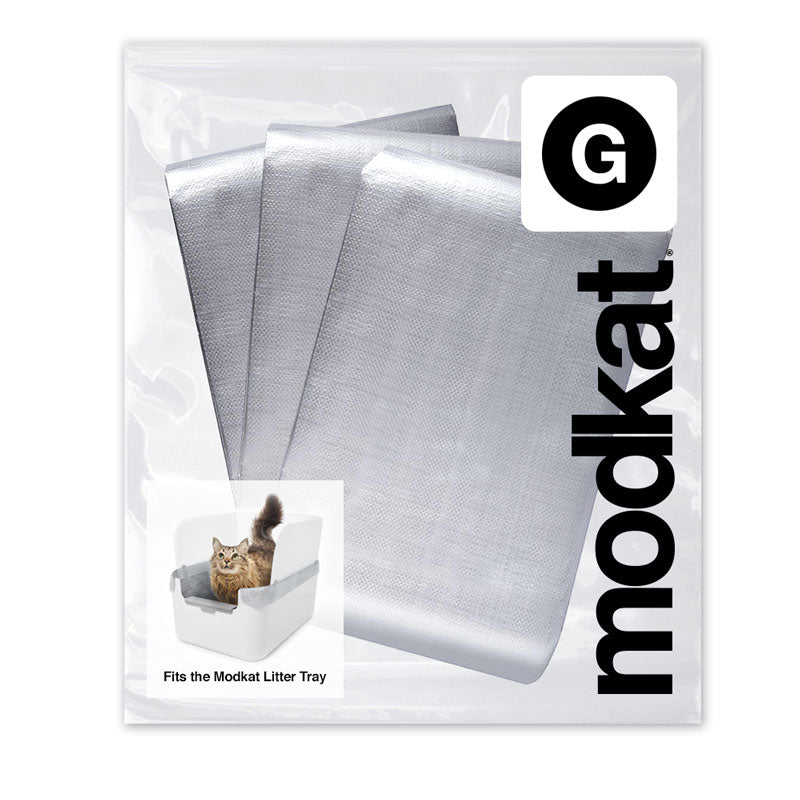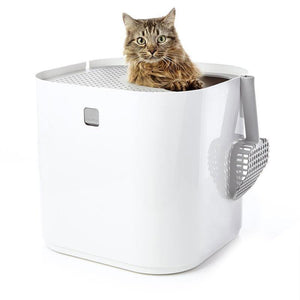Litter Boxes
Accessories
Liners
Which are the toughest litter box liners on the market?

You can keep your cat's litter box from becoming a noxious mess.
When mixed with cat pee (or 💩), litter pellets can harden like mortar and adhere to the bottom of the litter box.
That's not good for your cat or your home.
Litter box liners can help keep cat boxes clean, fresh, and undamaged. But with all the liners on the market, how do you know which one to purchase?
Here's our guide to the best litter box liners money can buy.
Types of litter box liners.
All cat litter liners are not alike. In fact, they come in a wide variety of styles, sizes, elements, and types.
Disposable plastic liners.
Many litter box liners are made from disposable plastic. These products vary in size and thickness, and you can purchase them from one of several manufacturers.
Some disposable plastic liners work pretty well. They almost fit the dimensions of the box and are thick enough not to tear when vigorously scratched. If made from durable material, disposable liners hold several scoops of litter when picked up and carried to the trash.
As many pet parents have discovered, however, a lot of disposable plastic litter box liners just don't work. They aren't thick enough to hold litter or easy enough to grab. You end up with a bigger mess than if you had never used a liner.
Even if you discover a product that works, there's still one major problem all disposable liners share:
They're terrible for the environment.
Plastic is not biodegradable. It has to meet its end in one of two ways — incineration or thermal destruction. Incineration requires waste management professionals to burn plastic at high temperatures, which releases harmful chemicals into the atmosphere. Thermal destruction takes 400 years.
In other words, every time we make plastic, we have to plan to keep it forever. Single-use plastics are harmful to the planet. Durable materials last longer, meaning you can use one heavy liner or 13 disposable plastic liners to do the exact same job.
Recycled plastic liners.
Some companies have tried to minimize liners' impact on the environment by creating recycled plastic liners.
To be clear, we're not talking about putting your used litter liner in the recycling bin. That doesn't work. Toss your used liners in the trash.
When we talk about recycled plastic liners, we mean using recycled plastic to make the liners. Some companies have taken this idea a step further by creating biodegradable liners.
For example, we created the Modkat Flip Paperboard Liners. These biodegradable liners are made from a single, seamless, coated sheet of recycled paperboard and last up to a month.
Scented litter box liners.
Some cat owners love scented products — cat litter, plug-ins, sprays, candles, and potpourris. So it's not surprising that someone came up with scented litter box liners.
Owners may like these products, but cats usually don't. Your pet's sense of smell is about 14 times as strong as yours. So if it's powerful to you, it's probably eye-watering to your cat.
Mixing any artificial scent with the smell of waste doesn't sound appealing, anyway. Try mixing baking soda or activated charcoal with your litter, or consider investing in our Modkat Litter Box Filter Kit.
Your house should smell better, and your cat will be happier and healthier than she will with a lavender-scented liner.
Plastic trash bags.
Pets cost money. Sometimes, they cost a lot of money. It's tempting to try to trim your budget by cutting corners on things like food, litter, toys, bowls, or liners.
Totally understandable! But probably not a good idea.
One way people try to save is by using plastic trash bags instead of dedicated litter liners. It sounds like a great idea, but it can unleash a host of problems, including litter box aversion. Here's why:
Garbage bags are made to line trash cans, not litter boxes. They don't fit your box right. Ill-fitting liners can shift and fold, creating spaces for urine to pool. Also, cats like to scratch in the box. Trash bags aren't made to withstand a cat's claws, so they can rip or even catch your pet's claws.
It's not fun trying to clean up a box with a shredded liner. Invest a few more dollars and cents in a dedicated litter liner. You'll be glad you did.
Sifting litter box liners.
Some companies manufacture litter box liners with holes in them — on purpose. The idea is that you can avoid having to scoop the box by picking up the liner and shaking it. The smaller pieces will fall through the holes and the bigger clumps will stay inside the liner.
People who like these liners say they help lengthen the life of their litter. Others say they're thin, flimsy, and easy to tear. In general, these liners seem like more work than reward.
Make-your-own litter box liner.
If you're into living the frugal life, you can DIY your own litter box liners. Here's a step-by-step guide to doing so.
- Buy a box of jumbo size trash-and-lawn bags and a roll of parchment at your local discount retailer.
- Take out the first bag. Unfold it.
- Cut the bag in half with a pair of scissors. You'll have an opening on one end of the bag.
- Use your scissors to cut a piece of parchment that will fold over the opening.
- Place the open end of your plastic bag inside the folded piece of parchment.
- Iron the parchment.
- Your trash bag is sealed and ready to go.
If you want to make your own sifting litter box liners, simply cut holes in the one you made.
Reusable litter box liners.
We saved the best for last.
Our Modkat Reusable Litter Box Liners fit perfectly inside our boxes. We formed them from tough, durable tarpaulin so they last at least three months. )Some of our satisfied customers say it's more like 4-6 months, but we don't want to brag.)
These liners are smooth enough for cats to scratch but strong enough not to rip or tear. Even better, you can just wipe them off with a damp cloth — or a little dish detergent if you like — when you change the litter. No shaking or sifting required. And since they're reusable, these bags also help limit environmental costs.
Litter box liners are supposed to save you work. They should cut down on the mess, help control odor, and make life better for you and your cat.
If your cat box liners aren't making your life easier, you need new liners.
How to choose the best litter box liners
What size liner do you need?
Your liner needs to fit snugly inside your cat's box. Easy to say, but it can be tough to figure out. Cat litter boxes come in a wide variety of shapes, sizes, and styles.
The perfect-size box is as long as your cat from the tip of his nose to the tip of his tail. The box should be as wide as the cat is long, minus his tail. Your cat's box needs to be high enough to keep your high-peeing cat from overshooting the walls.
Following these rules, your box will probably be between 16 and 21 inches long. It can run 14-16.5 inches wide. Your litter box liners should fit these measurements with just enough space to slip inside the box neatly.
How should your litter box liner fit?
When choosing a cat litter liner, apply the Goldilocks Rule. Look for something that's not too big and not too small — it's just right.
If your litter box liner comes up over the rim of the box, your cat can knock it loose. If your liner is too small, though, you won't be able to pick up all the litter without spilling a lot of it. Poor-fitting liners can also tear or sag.
Besides, they look terrible. If you've seen a liner come bulging out of a cat's box, you know how unattractive that appears. Find a liner that fits your box.
How thick should your liner be?
In general, the thicker the liner, the more durable the liner.
Cat litter is heavy. It's even heavier when it's wet. Your liner should be thick enough to hold two inches of wet cat litter when you pick it up.
Most hefty disposable litter liners will be about two millimeters thick. Our Modkat reusable liners run about three millimeters thick, and our Flip paperboard liners run a little less.
Construction material matters more than thickness, anyway. Single-use plastic just doesn't hold like paperboard or tarpaulin does, no matter how thick it is.
Will this liner control odors?
Liners help control odors in at least one of three ways.
First, they keep the plastic box from coming into contact with the cat waste. This means the box won't absorb the bacteria from the waste.
Second, a scented liner will help mask the bathroom smells. As we said above, though, scented liners can cause problems for cats' sensitive noses.
Third, some litter liners contain activated charcoal. This product helps destroy odors without masking them. Plus, it's 100% safe for cats. In fact, our Modkat odor control kit uses activated charcoal as its primary ingredient.
For best odor control, your liner should be the right size and durability to keep your plastic box clean. A touch of activated charcoal or baking soda in the can won't hurt either.
Is this litter box liner easy to use?
Cat litter box liners should make your life easier.
Some liners come with twist-on ties to secure the opening. Others use a drawstring. A few make you tie up the loose ends yourself. Our Modkat liners keep their shape so you just need to pick them up and carry them to the trash bin.
Cleaning up cat litter in the box is one thing; cleaning up cat litter that a defective liner spilled all over your clean floor is another!
Whatever liner you choose, make sure it's a help, not a hindrance at cleaning time.
4 benefits of litter box liners.
What good is a litter box liner anyway?
Here are four reasons a liner may help you and your cat stay happy and healthy.
1. Liners make cleaning the litter box easy.
Without a well-fitting liner, you're going to have some trouble getting all the litter pebbles out of your cat's litter station.
A liner lets you gather the litter and lift it out in a single motion. There's no scrambling to scoop and sweep the box.
Plus, you won't have to worry about scrubbing the sides of the box or trying to get a crusty mix of pee and old cat litter off the box's floor.
2. Liners keep the box hygienic.
Cats scratch when they use the bathroom.
It's a behavior they developed in the wild where masking the scent of their excrement could mean the difference between life and death. In nature, cats are both predator and prey. So a large carnivorous animal could track a small cat by its spoor.
Today, cats keep scratching even though they may go through life without once facing a deadly predator.
While this behavior may protect them in the wild, it does nothing for the state of a modern litter box. The hard plastic gets scratched, bacteria sneaks into the crevice, and soon you've got an unhealthy, unhygienic mess on your hands. When that happens, you might as well buy a new box.
A liner is a great way to keep your box clean and save money.
3. Reusable liners are not expensive.
Liners don't come for free, even if you make them yourself. A box of litter liners can run you anywhere from $3 to $23 and last from one to three months.
Our Modkat reusable liners run $39.99 for a three-pack. Each liner lasts three months.
3 Liners x 3 Months = 9 Months
That comes out to less than $5 a month for our durable liners.
Trust us on this, you don't want to raise a cat without a liner. Splurge on your kitty's health and happiness. It's worth it… and so is your cat.
4. Liners protect the box's plastic shell.
A cat litter liner protects your box.
Cat litter boxes are made from hard plastic. Cats like to scratch, and even the most durable plastic can get scrapes and dings. Plus, plastic will absorb bacteria from feline urine and feces, causing the box to develop an odor that even vigorous scrubbing won't eliminate.
Your litter box — especially if you bought a long-lasting one — is a big investment in a pet product. Protect your box with a high-quality litter liner.
3 issues with litter liners.
Are litter liners perfect?
No.
Aren't there pros and cons to using a litter liner?
Yes, but they mostly have to do with the kind of liner you choose.
Here's what we mean:
Sharp cat claws can tear flimsy liners.
If you choose a thin liner made from cheap plastic, your cat is almost guaranteed to rip a hole in it.
Rips in liners cause two problems.
First, they'll let dirty litter drop to the floor when you're cleaning out your box. You might as well not have a litter liner.
The second problem is actually worse. Your cat can get their claws hung in the liner. A trapped claw can hurt or frighten a cat. Some pets even develop litter box aversion, refusing to use the box, after getting their claws hung in the plastic.
When you purchase litter liners, make sure to pick something durable enough to withstand your kitty's most vigorous scratching.
Sifting can be dusty.
Some cat litter products are dusty. If you start sifting, shaking, and pouring them in a liner, these litters send a cloud of litter dust into the air.
You can avoid dusty box changes by taking these three steps:
- Choose a low-dust litter. Clumping litters trend to the less-dusty side as do a lot of the environmentally friendly litter types. Consider paper pellets, wood pellets, walnut shells, or grass seed.
- Select a covered litter box. In the only scientifically valid study on this question, 85% of cats either preferred a covered box or had no preference regarding covers. A covered box will help keep litter dust where it belongs.
- Pour close to the bottom and use less litter. Two inches of litter should be enough. More can be annoying to your cat.
You still have to dispose of the litter.
If you have a cat, you will have to buy litter, put it in a box, clean it up, and dispose of it. No box, liner, or scoop can undo that reality of a cat parent's life.
But you can make it easier to dispose of your cat's used litter by investing in a durable, reusable litter liner that fits your box like it was made to be there.
“It looks nicer than any other hooded or open option we considered.”

Purrr News.
Join our email list and get exclusive access to new products, the best cat litter box health articles, and 10% off your first order!
Similar products related to this blog:
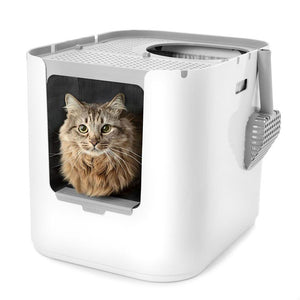
"It looks nicer than any other hooded or open option we considered."

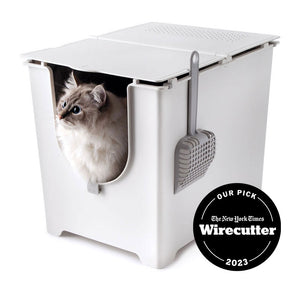
"This litter box keeps everything in, nothing gets out the sides."
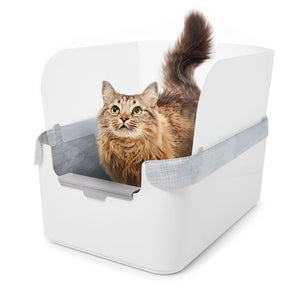
"My beautiful ragdoll cat and I both love the new Modkat Litter tray!"

